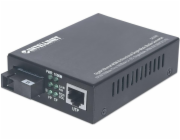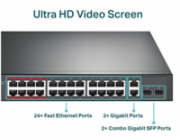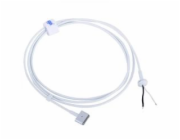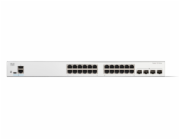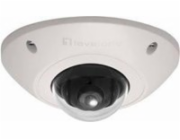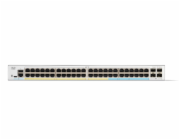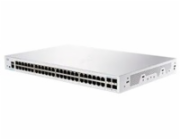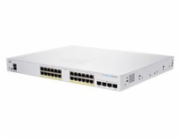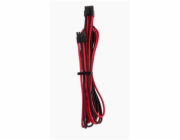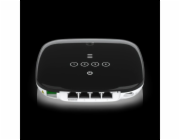KATEGORIE
Kategorie: Síťové prvky aktivní
3568 Kč
cena s DPH
Intellinet Network Solutions Obousměrný Media WDM konvertor Gigabit Single Module (545068)
6309 Kč
cena s DPH
TP-Link switch TL-SL1226P
24portový 10/100 Mb/s + 2portový gigabitový switch do racku s 24 porty PoE+
Vyhovuje standardu 802.3af/at PoE + a podporuje až 30 W napájení na každém PoE portu. Celkový výkon napájení až 250 W PoE pro 24× PoE porty, umožňuje široké spektrum aplikací, jako je dohled, kanceláře, koleje a malé podniky. Je plně kompatibilní s IP kamerami, přístupovými body, IP telefony, počítači, tiskárnami atd.
24 portů RJ45 PoE + 10/100Mb/s, 2 gigabitové porty RJ45 a 2 kombinované gigabitové SFP sloty
Vysoký výkon PoE napájení, až 30 W pro každý PoE port a 250 W pro všechny PoE porty
Přenos dat a PoE napájení až do vzdálenosti 250 m v režimu prodloužení, speciálně navrženého pro dohledový systém
Prioritní režim zajišťuje vysokou prioritu portů 1–8 a zaručuje kvalitu citlivých aplikací, jako je video monitor
Režim izolace umožňuje oddělení provozu klienta jedním kliknutím pro vyšší zabezpečení a výkon
Plug and play, bez nutnosti konfigurace a instalace
Stránky produktu: https://www.tp-link.com/cz/business-networking/unmanaged-switch/tl-sl1226p/
Technické specifikace
HARDWARE FEATURES
Interface
24× PoE+ 10/100 Mbps RJ45 Ports 2× 10/100/1000 Mbps RJ45 Ports 2× Combo Gigabit SFP Slots
Network Media
10BASE-T: UTP category 3, 4, 5 cable (maximum 100m) EIA/TIA-568 100Ohm STP (maximum 100m) 100BASE-TX: UTP category 5, 5e cable (maximum 100m) EIA/TIA-568 100Ohm STP (maximum 100m) 1000BASE-T: UTP category 5, 5e, 6 or above cable (maximum 100m) EIA/TIA-568 100Ohm STP (maximum 100m) 1000BASE-X MMF, SMF
Fan Quantity
2 Fans
Physical Security Lock
Yes
Power Supply
100-240 VAC, 50/60 Hz
Backup Bandwidth
8.8 Gbps
Packet Forwarding Rate
6.5472 Mpps
PoE+ Ports(RJ45)
Standard: 802.3at/802.3af compliant PoE Ports: Port 1 – Port 24 PoE Power Budget: 250 W
Mac Address Table
8 K
Jumbo Frame
10 KB
Switching Capacity
8.8 Gbps
Dimensions ( W x D x H )
17.3 × 7.1 × 1.7 in (440 × 180 × 44 mm)
Max Power Consumption
18.32 W (220/50 Hz. no PD connected) 294 W (220/50 Hz. with 250 W PD connected)
Max Heat Dissipation
62.47 BTU/h (no PD connected) 1002.54 BTU/h (with 250 W PD connected)
SOFTWARE FEATURES
Advanced Features
Compatible With IEEE 802.3at/af Compliant PDs Extend Mode (Up to 250m PoE power supply and data transmission) Priority Mode Isolation Mode PD Detection Intelligent Power Supply Mac Address Auto-Learning and Auto-Aging IEEE802.3x Flow Control
Transmission Method
Store-And-Forward
OTHERS
Certification
CE, FCC, RoHS
Package Contents
TL-SL1226P Power Cable Installation Guide Two mounting brackets and the fittings
Environment
Operating Temperature: 0–50 °C (32–122 °F) Storage Temperature: -40–70 °C (-40–158 °F) Operating Humidity: 10–90% non-condensing Storage Humidity: 5–90% non-condensing
7394 Kč
cena s DPH
Cisco Catalyst switch C1200-8FP-2G
Sada pro montáž do racku není součástí balení.
Řada Cisco Catalyst 1200 je další generací cenově dostupných chytrých přepínačů, které kombinují vysoký výkon a spolehlivost s kompletní sadou funkcí, které potřebujete pro malé a středně velké podnikové sítě. Přepínače fungují na přizpůsobeném softwaru operačního systému Linux a poskytují flexibilní možnosti správy, komplexní možnosti zabezpečení a funkce statického směrování na 3. vrstvě, které daleko přesahují možnosti neřízeného nebo levného přepínače a to za nižší cenu než u plně spravovaných přepínačů. Když potřebujete spolehlivé řešení pro sdílení online zdrojů a připojení počítačů, telefonů a bezdrátových přístupových bodů, chytré přepínače Catalyst řady 1200 poskytují ideální řešení za dostupnou cenu.
Stránky produktu: C1200-8FP-2G
Performance Switching capacity and forwarding rate (All switches are wire-speed and nonblocking)
Capacity in millions of packets per second (mpps) (64-byte packets) 14,88
Switching capacity in gigabits per second (Gbps) 20
Layer 2 switching Spanning Tree Protocol (STP) Standard 802.1d spanning tree support
Fast convergence using 802.1w (Rapid Spanning Tree Protocol [RSTP]), enabled by default
Multiple spanning tree instances using 802.1s (MSTP); 8 instances are supported
Per-VLAN Spanning Tree Plus (PVST+); 126 instances are supported
Rapid PVST+ (RPVST+); 126 instances are supported
Port grouping/link aggregation Support for IEEE 802.3ad Link Aggregation Control Protocol (LACP)
Up to 4 groups
Up to 8 ports per group with 16 candidate ports for each (dynamic) 802.3ad Link Aggregation Group (LAG)
VLAN Support for up to 255 active VLANs simultaneously
Port-based and 802.1Q tag-based VLANs
Management VLAN
Guest VLAN
Auto Surveillance VLAN (ASV)
Voice VLAN Voice traffic is automatically assigned to a voice-specific VLAN and treated with appropriate levels of QoS. Voice Services Discovery Protocol (VSDP) delivers networkwide zero-touch deployment of voice endpoints and call control devices
Generic VLAN Registration Protocol (GVRP) and Generic Attribute Registration Protocol (GARP) Enable automatically propagation and configuration of VLANs in a bridged domain
Internet Group Management Protocol (IGMP) versions 1, 2, and 3 snooping Limits bandwidth-intensive multicast traffic to only the requesters; supports 255 multicast groups (source-specific multicasting is also supported)
IGMP querier Used to support a Layer 2 multicast domain of snooping switches in the absence of a multicast router
Head-of-Line (HOL) blocking HOL blocking prevention
Loopback detection Provides protection against loops by transmitting loop protocol packets out of ports on which loop protection has been enabled. It operates independently of STP
Layer 3 routing IPv4 routing Wire-speed routing of IPv4 packets
Up to 32 static routes and up to 16 IP interfaces
IPv6 routing Wire-speed routing of IPv6 packets
Layer 3 interface Configuration of Layer 3 interface on physical port, LAG, VLAN interface, or loopback interface
Classless Interdomain Routing (CIDR) Support for CIDR
Dynamic Host Configuration Protocol (DHCP) relay at Layer 3 Relay of DHCP traffic across IP domains
User Datagram Protocol (UDP) relay Relay of broadcast information across Layer 3 domains for application discovery or relaying of Bootstrap Protocol (BootP)/DHCP packets
Security Secure Sockets Layer (SSL) Encrypts all HTTPS traffic, allowing secure access to the browser-based management GUI in the switch
SSH Protocol SSH is a secure replacement for Telnet traffic. Secure Copy (SCP) also uses SSH. SSH v1 and v2 are supported.
IEEE 802.1X (authenticator role) RADIUS authentication, guest VLAN, single/multiple host mode, and single/multiple sessions
STP loopback guard Provides additional protection against Layer 2 forwarding loops (STP loops)
Secure Core Technology (SCT) Ensures that the switch will receive and process management and protocol traffic no matter how much traffic is received
Secure Sensitive Data (SSD) A mechanism to manage sensitive data (such as passwords, keys, and so on) securely on the switch, populating this data to other devices and a secure auto-configuration. Access to view the sensitive data as plain text or encrypted is provided according to the user-configured access level and the access method of the user
Trustworthy systems Trustworthy systems provide a highly secure foundation for Cisco products
Run-time defenses (Executable Space Protection [X-Space], Address Space Layout Randomization [ASLR], Built-In Object Size Checking [BOSC])
Port security Ability to lock source MAC addresses to ports and limit the number of learned MAC addresses
RADIUS Supports RADIUS authentication for management access. Switch functions as a client
Storm control Broadcast, multicast, and unknown unicast
DoS prevention DoS attack prevention
Multiple user privilege levels in CLI Level 1, 7, and 15 privilege levels
ACLs Support for up to 512 rules
Drop or rate limit based on source and destination MAC, VLAN ID, IPv4 or IPv6 address, IPv6 flow label, protocol, port, Differentiated Services Code Point (DSCP)/IP precedence, TCP/UDP source and destination ports, 802.1p priority, Ethernet type, Internet Control Message Protocol (ICMP) packets, IGMP packets, TCP flag; ACL can be applied on both ingress and egress sides
Time-based ACLs supported
Quality of service Priority levels 8 hardware queues
Scheduling Strict priority and Weighted Round-Robin (WRR) queue assignment based on DSCP and Class of Service (802.1p/CoS)
Class of service Port based, 802.1p VLAN priority based, IPv4/v6 IP precedence/Type of Service (ToS)/DSCP based, Differentiated Services (DiffServ), classification and re-marking ACLs, trusted QoS
Rate limiting Ingress policer, egress shaping and rate control per VLAN, per port, and flow based
Congestion avoidance A TCP congestion avoidance algorithm is required to reduce and prevent global TCP loss synchronization
Standards Standards IEEE 802.3 10BASE-T Ethernet, IEEE 802.3u 100BASE-TX Fast Ethernet, IEEE 802.3ab 1000BASE-T Gigabit Ethernet, IEEE 802.3ad Link Aggregation Control Protocol, IEEE 802.3z Gigabit Ethernet, IEEE 802.3x Flow Control, IEEE 802.3 ad LACP, IEEE 802.1D (STP), IEEE 802.1Q/p VLAN, IEEE 802.1w RSTP, IEEE 802.1s Multiple STP, IEEE 802.1X Port Access Authentication, IEEE 802.3af, IEEE 802.3at, RFC 768, RFC 783, RFC 791, RFC 792, RFC 793, RFC 813, RFC 879, RFC 896, RFC 826, RFC 854, RFC 855, RFC 856, RFC 858, RFC 894, RFC 919, RFC 920, RFC 922, RFC 950, RFC 951, RFC 1042, RFC 1071, RFC 1123, RFC 1141, RFC 1155, RFC 1157, RFC 1213, RFC 1215, RFC 1286, RFC 1350, RFC 1442, RFC 1451, RFC 1493, RFC 1533, RFC 1541, RFC 1542, RFC 1573, RFC 1624, RFC 1643, RFC 1700, RFC 1757, RFC 1867, RFC 1907, RFC 2011, RFC 2012, RFC 2013, RFC 2030, RFC 2131, RFC 2132, RFC 2233, RFC 2576, RFC 2616, RFC 2618, RFC 2665, RFC 2666, RFC 2674, RFC 2737, RFC 2819, RFC 2863, RFC 3164, RFC 3411, RFC 3412, RFC 3413, RFC 3414, RFC 3415, RFC 3416, RFC 4330
IPv6 IPv6 IPv6 host mode
IPv6 over Ethernet
Dual IPv6/IPv4 stack
IPv6 Neighbor Discovery (ND)
IPv6 stateless address auto-configuration
Path Maximum Transmission Unit (MTU) discovery
Duplicate Address Detection (DAD)
ICMP version 6
IPv6 over IPv4 network with Intrasite Automatic Tunnel Addressing Protocol (ISATAP) support
IPv6 QoS Prioritizes IPv6 packets in hardware
IPv6 ACL Drop or rate-limit IPv6 packets in hardware
Multicast Listener Discovery (MLD v1/2) snooping Delivers IPv6 multicast packets only to the required receivers
IPv6 applications Web/SSL, Telnet server/SSH, Ping, Traceroute, Simple Network Ti
245 Kč
cena s DPH
Servisní kabel Akyga® AK-SC-33 slouží k výměně poškozeného kabelu v napájecím zdroji notebooku Ma...
12624 Kč
cena s DPH
Cisco Catalyst switch C1300-24T-4G
Cisco Catalyst řady 1300 jsou managovatelné switche Gigabit Ethernet Layer 3 podnikové třídy určené pro malé a střední podniky a pobočky. Tyto jednoduché, flexibilní a bezpečné switche jsou ideální pro nasazení mimo rozvodnou skříň. Řada Catalyst 1300 pracuje na přizpůsobeném softwaru operačního systému Linux s intuitivním grafickým rozhraním, který zjednodušuje nastavení sítě a pokročilými funkcemi, které urychlují digitální transformaci, zatímco všudypřítomné zabezpečení chrání kritické obchodní transakce. Přepínače řady 1300 poskytují ideální kombinaci cenové dostupnosti a možností pro malé a střední podniky a pomáhají vám vytvořit efektivnější a lépe propojenou pracovní sílu.
Stránky produktu: C1300-24T-4G
Performance Switching capacity and forwarding rate (All switches are wire-speed and nonblocking)
Capacity in millions of packets per second (mpps) (64-byte packets) 41.66
Switching capacity in gigabits per second (Gbps) 56.0
Layer 2 switching Spanning Tree Protocol (STP) Standard 802.1d spanning tree support
Fast convergence using 802.1w (Rapid Spanning Tree Protocol [RSTP]), enabled by default
Multiple spanning tree instances using 802.1s (MSTP); 8 instances are supported
Per-VLAN Spanning Tree Plus (PVST+); 126 instances are supported
Rapid PVST+ (RPVST+); 126 instances are supported
Port grouping/link aggregation Support for IEEE 802.3ad Link Aggregation Control Protocol (LACP)
Up to 8 groups
Up to 8 ports per group with 16 candidate ports for each (dynamic) 802.3ad link aggregation
VLAN Support for up to 4093 VLANs simultaneously
Port-based and 802.1Q tag-based VLANs, MAC-based VLAN, protocol-based VLAN, IP subnet-based VLAN
Management VLAN
Private VLAN with promiscuous, isolated, and community port
Private VLAN Edge (PVE), also known as protected ports, with multiple uplinks Guest VLAN, unauthenticated VLAN
Dynamic VLAN assignment via RADIUS server along with 802.1X client authentication Customer premises equipment (CPE) VLAN
Auto surveillance VLAN (ASV)
Voice VLAN Voice traffic is automatically assigned to a voice-specific VLAN and treated with appropriate levels of QoS. Voice Services Discovery Protocol (VSDP) delivers networkwide zero-touch deployment of voice endpoints and call control devices
Multicast TV VLAN Multicast TV VLAN allows the single multicast VLAN to be shared in the network while subscribers remain in separate VLANs. This feature is also known as Multicast VLAN Registration (MVR)
VLAN translation Support for VLAN one-to-one mapping, in which customer VLANs (C-VLANs) on an edge interface are mapped to service provider VLANs (S-VLANs), and the original C-VLAN tags are replaced by the specified S-VLAN
Q-in-Q VLANs transparently cross a service provider network while isolating traffic among customers
Selective Q-in-Q Selective Q-in-Q is an enhancement to the basic Q-in-Q feature and provides, per edge interface, multiple mappings of different C-VLANs to separate S-VLANs
Selective Q-in-Q also allows configuring of the Ethertype (Tag Protocol Identifier [TPID]) of the S-VLAN tag
Layer 2 protocol tunneling over Q-in-Q is also supported
Generic VLAN Registration Protocol (GVRP)/Generic Attribute Registration Protocol (GARP) GVRP and GARP enable automatic propagation and configuration of VLANs in a bridged domain
Unidirectional Link UDLD monitors physical connections to detect unidirectional links caused by incorrect
Detection (UDLD) wiring or cable/port faults to prevent forwarding loops and blackholing of traffic in switched networks
DHCP relay at Layer 2 Relay of DHCP traffic to a DHCP server in a different VLAN; works with DHCP Option 82
Internet Group Management Protocol (IGMP) versions 1, 2, and 3 snooping IGMP limits bandwidth-intensive multicast traffic to only the requesters; it supports 2000 multicast groups (source-specific multicasting is also supported)
IGMP querier IGMP querier is used to support a Layer 2 multicast domain of snooping switches in the absence of a multicast router
IGMP proxy The IGMP proxy provides a mechanism for multicast forwarding based on IGMP membership information without the need for more complicated multicast routing protocols
Head-of-Line (HOL) blocking HOL blocking prevention
Loopback detection Loopback detection provides protection against loops by transmitting loop protocol packets out of ports on which loop protection has been enabled. It operates independently of STP
Layer 3 IPv4 routing Wire-speed routing of IPv4 packets
Up to 990 static routes and up to 128 IP interfaces
IPv6 routing Wire-speed routing of IPv6 packets
Layer 3 interface Configuration of a Layer 3 interface on a physical port, LAG, VLAN interface, or loopback interface
Classless Interdomain Routing (CIDR) Support for CIDR
Routing Information Protocol (RIP) v2 Support for RIP v2 for dynamic routing
Policy-Based Routing (PBR) Flexible routing control to direct packets to a different next hop based on an IPv4 or IPv6 Access Control List (ACL)
DHCP server Switch functions as an IPv4 DHCP server, serving IP addresses for multiple DHCP pools or scopes
Support for DHCP options
DHCP relay at Layer 3 Relay of DHCP traffic across IP domains
User Datagram Protocol (UDP) relay Relay of broadcast information across Layer 3 domains for application discovery or relaying of Bootstrap Protocol (BOOTP)/DHCP packets
Security Secure Shell (SSH) Protocol SSH is a secure replacement for Telnet traffic. Secure Copy Protocol (SCP) also uses SSH. SSH v1 and v2 are supported
Secure Sockets Layer (SSL) SSL support: Encrypts all HTTPS traffic, allowing highly secure access to the browser-based management GUI in the switch
IEEE 802.1X (authenticator role) 802.1X: RADIUS authentication and accounting, MD5 hash, guest VLAN, unauthenticated VLAN, single/multiple host mode, and single/multiple sessions
Supports time-based 802.1X, dynamic VLAN assignment, and MAC authentication
IEEE 802.1X supplicant A switch can be configured to act as a supplicant to another switch. This enables extended secure access in areas outside the wiring closet (such as conference rooms)
Web-based authentication Web-based authentication provides network admission control through a web browser to any host devices and operating systems
STP Bridge Protocol Data Unit (BPDU) Guard A security mechanism to protect the network from invalid configurations. A port enabled for BPDU Guard is shut down if a BPDU message is received on that port. This avoids accidental topology loops
STP Root Guard Prevents edge devices not in the network administrator’s control from becoming STP root nodes
STP loopback guard Provides additional protection against Layer 2 forwarding loops (STP loops)
DHCP snooping Filters out DHCP messages with unregistered IP addresses and/or from unexpected or untrusted interfaces. This prevents rogue devices from behaving as DHCP servers
IP Source Guard (IPSG) When IPSG is enabled at a port, the switch filters out IP packets received from the port if the source IP addresses of the packets have not been statically configured or dynamically learned from DHCP snooping. This prevents IP address spoofing
Dynamic ARP Inspection (DAI) The switch discards ARP packets from a port if there are no static or dynamic IP/MAC bindings or if there is a discrepancy between the source or destination addresses in the ARP packet. This prevents man-in-the-middle attacks
IP/MAC/port binding (IPMB) The preceding features (DHCP snooping, IPSG, and DAI) work together to prevent Denial-of-Service (DoS) attacks in the network, thereby increasing network availability
Secure Core Technology (SCT) Makes sure that the switch will receive and
1478 Kč
cena s DPH
Apple HomeKit: ne
Amazon Alexa: ne
Google Assistant: ne
IFTTT: ne
Z-Wave: ne
ZigBee: ne
WLAN: ano
Bluetooth: ne
Vhodné pro App: ne
Rozlišení: 1920 x 1080
Infračervené světlo: ano
H.264: ano
MJPEG: ano
Typ: Síťová kamera
Ochrana proti vodě: ano
Typ ochrany: IP66
Síť (Ethernet): 10 / 100
Mikrofón: ne
Reproduktory: ne
2-way audio: ne
Detekce pohybu: ne
Funkce nočního vidění: ano
Slot pro paměťovou kartu: microSD / microSDHC
WPS tlačítko (WiFi Protected Setup): ne
zásobování energií: Síť
Oblast použití: Interiér / Exteriér
Barva: bílá
Montáž na strop možná: ano
Montáž na zeď možná: ano
19798 Kč
cena s DPH
Cisco Catalyst switch C1300-48T-4G
Cisco Catalyst řady 1300 jsou managovatelné switche Gigabit Ethernet Layer 3 podnikové třídy určené pro malé a střední podniky a pobočky. Tyto jednoduché, flexibilní a bezpečné switche jsou ideální pro nasazení mimo rozvodnou skříň. Řada Catalyst 1300 pracuje na přizpůsobeném softwaru operačního systému Linux s intuitivním grafickým rozhraním, který zjednodušuje nastavení sítě a pokročilými funkcemi, které urychlují digitální transformaci, zatímco všudypřítomné zabezpečení chrání kritické obchodní transakce. Přepínače řady 1300 poskytují ideální kombinaci cenové dostupnosti a možností pro malé a střední podniky a pomáhají vám vytvořit efektivnější a lépe propojenou pracovní sílu.
Stránky produktu: C1300-48T-4G
Performance Switching capacity and forwarding rate (All switches are wire-speed and nonblocking)
Capacity in millions of packets per second (mpps) (64-byte packets) 77.38
Switching capacity in gigabits per second (Gbps) 104.0
Layer 2 switching Spanning Tree Protocol (STP) Standard 802.1d spanning tree support
Fast convergence using 802.1w (Rapid Spanning Tree Protocol [RSTP]), enabled by default
Multiple spanning tree instances using 802.1s (MSTP); 8 instances are supported
Per-VLAN Spanning Tree Plus (PVST+); 126 instances are supported
Rapid PVST+ (RPVST+); 126 instances are supported
Port grouping/link aggregation Support for IEEE 802.3ad Link Aggregation Control Protocol (LACP)
Up to 8 groups
Up to 8 ports per group with 16 candidate ports for each (dynamic) 802.3ad link aggregation
VLAN Support for up to 4093 VLANs simultaneously
Port-based and 802.1Q tag-based VLANs, MAC-based VLAN, protocol-based VLAN, IP subnet-based VLAN
Management VLAN
Private VLAN with promiscuous, isolated, and community port
Private VLAN Edge (PVE), also known as protected ports, with multiple uplinks Guest VLAN, unauthenticated VLAN
Dynamic VLAN assignment via RADIUS server along with 802.1X client authentication Customer premises equipment (CPE) VLAN
Auto surveillance VLAN (ASV)
Voice VLAN Voice traffic is automatically assigned to a voice-specific VLAN and treated with appropriate levels of QoS. Voice Services Discovery Protocol (VSDP) delivers networkwide zero-touch deployment of voice endpoints and call control devices
Multicast TV VLAN Multicast TV VLAN allows the single multicast VLAN to be shared in the network while subscribers remain in separate VLANs. This feature is also known as Multicast VLAN Registration (MVR)
VLAN translation Support for VLAN one-to-one mapping, in which customer VLANs (C-VLANs) on an edge interface are mapped to service provider VLANs (S-VLANs), and the original C-VLAN tags are replaced by the specified S-VLAN
Q-in-Q VLANs transparently cross a service provider network while isolating traffic among customers
Selective Q-in-Q Selective Q-in-Q is an enhancement to the basic Q-in-Q feature and provides, per edge interface, multiple mappings of different C-VLANs to separate S-VLANs
Selective Q-in-Q also allows configuring of the Ethertype (Tag Protocol Identifier [TPID]) of the S-VLAN tag
Layer 2 protocol tunneling over Q-in-Q is also supported
Generic VLAN Registration Protocol (GVRP)/Generic Attribute Registration Protocol (GARP) GVRP and GARP enable automatic propagation and configuration of VLANs in a bridged domain
Unidirectional Link UDLD monitors physical connections to detect unidirectional links caused by incorrect
Detection (UDLD) wiring or cable/port faults to prevent forwarding loops and blackholing of traffic in switched networks
DHCP relay at Layer 2 Relay of DHCP traffic to a DHCP server in a different VLAN; works with DHCP Option 82
Internet Group Management Protocol (IGMP) versions 1, 2, and 3 snooping IGMP limits bandwidth-intensive multicast traffic to only the requesters; it supports 2000 multicast groups (source-specific multicasting is also supported)
IGMP querier IGMP querier is used to support a Layer 2 multicast domain of snooping switches in the absence of a multicast router
IGMP proxy The IGMP proxy provides a mechanism for multicast forwarding based on IGMP membership information without the need for more complicated multicast routing protocols
Head-of-Line (HOL) blocking HOL blocking prevention
Loopback detection Loopback detection provides protection against loops by transmitting loop protocol packets out of ports on which loop protection has been enabled. It operates independently of STP
Layer 3 IPv4 routing Wire-speed routing of IPv4 packets
Up to 990 static routes and up to 128 IP interfaces
IPv6 routing Wire-speed routing of IPv6 packets
Layer 3 interface Configuration of a Layer 3 interface on a physical port, LAG, VLAN interface, or loopback interface
Classless Interdomain Routing (CIDR) Support for CIDR
Routing Information Protocol (RIP) v2 Support for RIP v2 for dynamic routing
Policy-Based Routing (PBR) Flexible routing control to direct packets to a different next hop based on an IPv4 or IPv6 Access Control List (ACL)
DHCP server Switch functions as an IPv4 DHCP server, serving IP addresses for multiple DHCP pools or scopes
Support for DHCP options
DHCP relay at Layer 3 Relay of DHCP traffic across IP domains
User Datagram Protocol (UDP) relay Relay of broadcast information across Layer 3 domains for application discovery or relaying of Bootstrap Protocol (BOOTP)/DHCP packets
Security Secure Shell (SSH) Protocol SSH is a secure replacement for Telnet traffic. Secure Copy Protocol (SCP) also uses SSH. SSH v1 and v2 are supported
Secure Sockets Layer (SSL) SSL support: Encrypts all HTTPS traffic, allowing highly secure access to the browser-based management GUI in the switch
IEEE 802.1X (authenticator role) 802.1X: RADIUS authentication and accounting, MD5 hash, guest VLAN, unauthenticated VLAN, single/multiple host mode, and single/multiple sessions
Supports time-based 802.1X, dynamic VLAN assignment, and MAC authentication
IEEE 802.1X supplicant A switch can be configured to act as a supplicant to another switch. This enables extended secure access in areas outside the wiring closet (such as conference rooms)
Web-based authentication Web-based authentication provides network admission control through a web browser to any host devices and operating systems
STP Bridge Protocol Data Unit (BPDU) Guard A security mechanism to protect the network from invalid configurations. A port enabled for BPDU Guard is shut down if a BPDU message is received on that port. This avoids accidental topology loops
STP Root Guard Prevents edge devices not in the network administrator’s control from becoming STP root nodes
STP loopback guard Provides additional protection against Layer 2 forwarding loops (STP loops)
DHCP snooping Filters out DHCP messages with unregistered IP addresses and/or from unexpected or untrusted interfaces. This prevents rogue devices from behaving as DHCP servers
IP Source Guard (IPSG) When IPSG is enabled at a port, the switch filters out IP packets received from the port if the source IP addresses of the packets have not been statically configured or dynamically learned from DHCP snooping. This prevents IP address spoofing
Dynamic ARP Inspection (DAI) The switch discards ARP packets from a port if there are no static or dynamic IP/MAC bindings or if there is a discrepancy between the source or destination addresses in the ARP packet. This prevents man-in-the-middle attacks
IP/MAC/port binding (IPMB) The preceding features (DHCP snooping, IPSG, and DAI) work together to prevent Denial-of-Service (DoS) attacks in the network, thereby increasing network availability
Secure Core Technology (SCT) Makes sure that the switch will receive an
378 Kč
cena s DPH
Extrémně kompaktní kabel pro použití se všemi zařízeními iPad, iPhone a iPod s konektorem Lightni...
30956 Kč
cena s DPH
Cisco Catalyst switch C1300-48T-4X
Cisco Catalyst řady 1300 jsou managovatelné switche Gigabit Ethernet Layer 3 podnikové třídy určené pro malé a střední podniky a pobočky. Tyto jednoduché, flexibilní a bezpečné switche jsou ideální pro nasazení mimo rozvodnou skříň. Řada Catalyst 1300 pracuje na přizpůsobeném softwaru operačního systému Linux s intuitivním grafickým rozhraním, který zjednodušuje nastavení sítě a pokročilými funkcemi, které urychlují digitální transformaci, zatímco všudypřítomné zabezpečení chrání kritické obchodní transakce. Přepínače řady 1300 poskytují ideální kombinaci cenové dostupnosti a možností pro malé a střední podniky a pomáhají vám vytvořit efektivnější a lépe propojenou pracovní sílu.
Stránky produktu: C1300-48T-4X
Performance Switching capacity and forwarding rate (All switches are wire-speed and nonblocking)
Capacity in millions of packets per second (mpps) (64-byte packets) 130.94
Switching capacity in gigabits per second (Gbps) 176.0
Layer 2 switching Spanning Tree Protocol (STP) Standard 802.1d spanning tree support
Fast convergence using 802.1w (Rapid Spanning Tree Protocol [RSTP]), enabled by default
Multiple spanning tree instances using 802.1s (MSTP); 8 instances are supported
Per-VLAN Spanning Tree Plus (PVST+); 126 instances are supported
Rapid PVST+ (RPVST+); 126 instances are supported
Port grouping/link aggregation Support for IEEE 802.3ad Link Aggregation Control Protocol (LACP)
Up to 8 groups
Up to 8 ports per group with 16 candidate ports for each (dynamic) 802.3ad link aggregation
VLAN Support for up to 4093 VLANs simultaneously
Port-based and 802.1Q tag-based VLANs, MAC-based VLAN, protocol-based VLAN, IP subnet-based VLAN
Management VLAN
Private VLAN with promiscuous, isolated, and community port
Private VLAN Edge (PVE), also known as protected ports, with multiple uplinks Guest VLAN, unauthenticated VLAN
Dynamic VLAN assignment via RADIUS server along with 802.1X client authentication Customer premises equipment (CPE) VLAN
Auto surveillance VLAN (ASV)
Voice VLAN Voice traffic is automatically assigned to a voice-specific VLAN and treated with appropriate levels of QoS. Voice Services Discovery Protocol (VSDP) delivers networkwide zero-touch deployment of voice endpoints and call control devices
Multicast TV VLAN Multicast TV VLAN allows the single multicast VLAN to be shared in the network while subscribers remain in separate VLANs. This feature is also known as Multicast VLAN Registration (MVR)
VLAN translation Support for VLAN one-to-one mapping, in which customer VLANs (C-VLANs) on an edge interface are mapped to service provider VLANs (S-VLANs), and the original C-VLAN tags are replaced by the specified S-VLAN
Q-in-Q VLANs transparently cross a service provider network while isolating traffic among customers
Selective Q-in-Q Selective Q-in-Q is an enhancement to the basic Q-in-Q feature and provides, per edge interface, multiple mappings of different C-VLANs to separate S-VLANs
Selective Q-in-Q also allows configuring of the Ethertype (Tag Protocol Identifier [TPID]) of the S-VLAN tag
Layer 2 protocol tunneling over Q-in-Q is also supported
Generic VLAN Registration Protocol (GVRP)/Generic Attribute Registration Protocol (GARP) GVRP and GARP enable automatic propagation and configuration of VLANs in a bridged domain
Unidirectional Link UDLD monitors physical connections to detect unidirectional links caused by incorrect
Detection (UDLD) wiring or cable/port faults to prevent forwarding loops and blackholing of traffic in switched networks
DHCP relay at Layer 2 Relay of DHCP traffic to a DHCP server in a different VLAN; works with DHCP Option 82
Internet Group Management Protocol (IGMP) versions 1, 2, and 3 snooping IGMP limits bandwidth-intensive multicast traffic to only the requesters; it supports 2000 multicast groups (source-specific multicasting is also supported)
IGMP querier IGMP querier is used to support a Layer 2 multicast domain of snooping switches in the absence of a multicast router
IGMP proxy The IGMP proxy provides a mechanism for multicast forwarding based on IGMP membership information without the need for more complicated multicast routing protocols
Head-of-Line (HOL) blocking HOL blocking prevention
Loopback detection Loopback detection provides protection against loops by transmitting loop protocol packets out of ports on which loop protection has been enabled. It operates independently of STP
Layer 3 IPv4 routing Wire-speed routing of IPv4 packets
Up to 990 static routes and up to 128 IP interfaces
IPv6 routing Wire-speed routing of IPv6 packets
Layer 3 interface Configuration of a Layer 3 interface on a physical port, LAG, VLAN interface, or loopback interface
Classless Interdomain Routing (CIDR) Support for CIDR
Routing Information Protocol (RIP) v2 Support for RIP v2 for dynamic routing
Policy-Based Routing (PBR) Flexible routing control to direct packets to a different next hop based on an IPv4 or IPv6 Access Control List (ACL)
DHCP server Switch functions as an IPv4 DHCP server, serving IP addresses for multiple DHCP pools or scopes
Support for DHCP options
DHCP relay at Layer 3 Relay of DHCP traffic across IP domains
User Datagram Protocol (UDP) relay Relay of broadcast information across Layer 3 domains for application discovery or relaying of Bootstrap Protocol (BOOTP)/DHCP packets
Stacking Hardware stacking Up to 8 switches in a stack. Up to 200 ports managed as a single system with hardware failover
Stacking is supported on the following models:
Family 1: C1300-16P-4X, C1300-24T-4X, C1300-24P-4X, C1300-24FP-4X, C1300-48T-4X, C1300-48P-4X, C1300-48FP-4X, C1300-8MGP-2X, C1300-24MGP-4X, C1300-48MGP-4X
Family 2: C1300-12XT-2X, C1300-12XS, C1300-16XTS, C1300-24XS, C1300-24XT, C1300-24XTS
PIDs from the same Family can be stacked together. Cross-stacking between Families is not supported.
High availability Fast stack failover delivers minimal traffic loss. Support for LAG across multiple units in a stack
Plug-and-play stacking configuration/management Active/standby for resilient stack control Auto-numbering
Hot swap of units in stack
Ring and chain stacking options, auto stacking port speed, flexible stacking port options
High-speed stack interconnects Cost-effective high-speed 10 Gigabit Ethernet fiber interfaces
Security Secure Shell (SSH) Protocol SSH is a secure replacement for Telnet traffic. Secure Copy Protocol (SCP) also uses SSH. SSH v1 and v2 are supported
Secure Sockets Layer (SSL) SSL support: Encrypts all HTTPS traffic, allowing highly secure access to the browser-based management GUI in the switch
IEEE 802.1X (authenticator role) 802.1X: RADIUS authentication and accounting, MD5 hash, guest VLAN, unauthenticated VLAN, single/multiple host mode, and single/multiple sessions
Supports time-based 802.1X, dynamic VLAN assignment, and MAC authentication
IEEE 802.1X supplicant A switch can be configured to act as a supplicant to another switch. This enables extended secure access in areas outside the wiring closet (such as conference rooms)
Web-based authentication Web-based authentication provides network admission control through a web browser to any host devices and operating systems
STP Bridge Protocol Data Unit (BPDU) Guard A security mechanism to protect the network from invalid configurations. A port enabled for BPDU Guard is shut down if a BPDU message is received on that port. This avoids accidental topology loops
STP Root Guard Prevents edge devices not in the network administrator’s control from becoming STP root nodes
STP loopback guard Provides additional protection against Layer 2 forwarding loops (STP loops)
D
1774 Kč
cena s DPH
Ubiquiti NanoBeam M5 16 dBi; NanoBeam (NBE-M5-16) je výkonná kompletní venkovní jednotka včetně 16 dBi MIMO 2x2 antény pro pásmo 5 GHz vhodná pro Point-to-Point a Point-to-Multipoint spoje. Jednotka umož...
7842 Kč
cena s DPH
Cisco switch CBS250-48T-4G - REFRESH
CISCO REFRESH jsou repasované produkty, které společnost CISCO dodává s certifikací kvality, zárukou a servisní podporou odpovídající ekvivalentnímu novému produktu
Řada Cisco Business 250 představuje novou generaci cenově dostupných inteligentních switchů, které kombinují vysoký síťový výkon, zabezpečení a spolehlivost s komplexní sadou síťových funkcí potřebných pro spolehlivou síť malých firem.
Záruka platná do End of Support 31. 10. 2029.
Oznámení End of Life pro CISCO CBS250
Stránky produktu: CBS250-48T-4G
Quick start guide: Quick start guide
Switching capacity (All switches are wire-speed and nonblocking) Forwarding rate in millions of packets per second (mpps; 64-byte packets) 77,38
Switching capacity in Gigabits per second (Gbps) 104
Layer 2 switching Spanning Tree Protocol (STP) Standard 802.1d spanning tree support
Fast convergence using 802.1w (Rapid Spanning Tree Protocol [RSTP]), enabled by default
Multiple spanning tree instances using 802.1s (MSTP); 8 instances are supported
Per-VLAN Spanning Tree Plus (PVST+); 126 instances are supported
Rapid PVST+ (RPVST+); 126 instances are supported
Port grouping/link aggregation Support for IEEE 802.3ad Link Aggregation Control Protocol (LACP)
Up to 4 groups
Up to 8 ports per group with 16 candidate ports for each (dynamic) 802.3ad Link Aggregation Group (LAG)
VLAN Support for up to 255 active VLANs simultaneously
Port-based and 802.1Q tag-based VLANs
Management VLAN
Guest VLAN
Voice VLAN Voice traffic is automatically assigned to a voice-specific VLAN and treated with appropriate levels of QoS. Voice Services Discovery Protocol (VSDP) delivers networkwide zero-touch deployment of voice endpoints and call control devices
Generic VLAN Registration Protocol (GVRP) and Generic Attribute Registration Protocol (GARP) Protocols for automatically propagating and configuring VLANs in a bridged domain
IGMP (versions 1, 2, and 3) snooping Internet Group Management Protocol (IGMP) limits bandwidth-intensive multicast traffic to only the requesters; supports 255 multicast groups (source-specific multicasting is also supported)
IGMP querier Used to support a Layer 2 multicast domain of snooping switches in the absence of a multicast router
HOL blocking Head-of-Line (HOL) blocking prevention
Loopback detection Provides protection against loops by transmitting loop protocol packets out of ports on which loop protection has been enabled. It operates independently of STP.
Layer 3 routing IPv4 routing Wire-speed routing of IPv4 packets
Up to 32 static routes and up to 16 IP interfaces
IPv6 routing Wire-speed routing of IPv6 packets
Layer 3 interface Configuration of Layer 3 interface on physical port, LAG, VLAN interface, or loopback interface
Classless Interdomain Routing (CIDR) Support for CIDR
Dynamic Host Configuration Protocol (DHCP) relay at Layer 3 Relay of DHCP traffic across IP domains
User Datagram Protocol (UDP) relay Relay of broadcast information across Layer 3 domains for application discovery or relaying of Bootstrap Protocol (BootP)/DHCP packets
Security Secure Sockets Layer (SSL) SSL encrypts all HTTPS traffic, allowing secure access to the browser-based management GUI in the switch
Secure Shell (SSH) Protocol SSH is a secure replacement for Telnet traffic. Secure Copy (SCP) also uses SSH. SSH v1 and v2 are supported.
IEEE 802.1X (authenticator role) Remote Authentication Dial-In User Service (RADIUS) authentication, guest VLAN, single/multiple host mode, and single/multiple sessions
STP loopback guard Provides additional protection against Layer 2 forwarding loops (STP loops)
Secure Core Technology (SCT) Ensures that the switch will receive and process management and protocol traffic no matter how much traffic is received
Secure Sensitive Data (SSD) A mechanism to manage sensitive data (such as passwords, keys, and so on) securely on the switch, populating this data to other devices, and secure autoconfig. Access to view the sensitive data as plain text or encrypted is provided according to the user-configured access level and the access method of the user
Trustworthy systems Trustworthy systems provide a highly secure foundation for Cisco products
Run-time defenses (Executable Space Protection [X-Space], Address Space Layout Randomization [ASLR], Built-In Object Size Checking [BOSC])
Port security Ability to lock source MAC addresses to ports and limit the number of learned MAC addresses
RADIUS Supports RADIUS authentication for management access. Switch functions as a client.
Storm control Broadcast, multicast, and unknown unicast
DoS prevention Denial-of-Service (DoS) attack prevention
Multiple user privilege levels in CLI Level 1, 7, and 15 privilege levels
Access Control Lists (ACLs) Support for up to 512 rules
Drop or rate limit based on source and destination MAC, VLAN ID or IPv4 or IPv6 address, IPv6 flow label, protocol, port, Differentiated Services Code Point (DSCP)/IP precedence, TCP/UDP source and destination ports, 802.1p priority, Ethernet type, Internet Control Message Protocol (ICMP) packets, IGMP packets, TCP flag; ACL can be applied on both ingress and egress sides
Time-based ACLs supported
QoS Priority levels 8 hardware queues
Scheduling Strict priority and Weighted Round-Robin (WRR) queue assignment based on DSCP and class of service (802.1p/CoS)
Class of service Port based; 802.1p VLAN priority based; IPv4/v6 IP precedence/Type of Service (ToS)/DSCP based; Differentiated Services (DiffServ); classification and re-marking ACLs, trusted QoS
Rate limiting Ingress policer; egress shaping and rate control; per VLAN, per port, and flow based
Congestion avoidance A TCP congestion avoidance algorithm is required to reduce and prevent global TCP loss synchronization
Standards Standards IEEE 802.3 10BASE-T Ethernet, IEEE 802.3u 100BASE-TX Fast Ethernet, IEEE 802.3ab 1000BASE-T Gigabit Ethernet, IEEE 802.3ad Link Aggregation Control Protocol, IEEE 802.3z Gigabit Ethernet, IEEE 802.3x Flow Control, IEEE 802.3 ad LACP, IEEE 802.1D (STP), IEEE 802.1Q/p VLAN, IEEE 802.1w RSTP, IEEE 802.1s Multiple STP, IEEE 802.1X Port Access Authentication, IEEE 802.3af, IEEE 802.3at, RFC 768, RFC 783, RFC 791, RFC 792, RFC 793, RFC 813, RFC 879, RFC 896, RFC 826, RFC 854, RFC 855, RFC 856, RFC 858, RFC 894, RFC 919, RFC 920, RFC 922, RFC 950, RFC 951, RFC 1042, RFC 1071, RFC 1123, RFC 1141, RFC 1155, RFC 1157, RFC 1213, RFC 1215, RFC 1286, RFC 1350, RFC 1442, RFC 1451, RFC 1493, RFC 1533, RFC 1541, RFC 1542, RFC 1573, RFC 1624, RFC 1643, RFC 1700, RFC 1757, RFC 1867, RFC 1907, RFC 2011, RFC 2012, RFC 2013, RFC 2030, RFC 2131, RFC 2132, RFC 2233, RFC 2576, RFC 2616, RFC 2618, RFC 2665, RFC 2666, RFC 2674, RFC 2737, RFC 2819, RFC 2863, RFC 3164, RFC 3411, RFC 3412, RFC 3413, RFC 3414, RFC 3415, RFC 3416, RFC 4330
IPv6 IPv6 IPv6 host mode
IPv6 over Ethernet
IPv6/IPv4 Dual Stack
IPv6 Neighbor Discovery (ND)
IPv6 stateless address auto configuration
Path Maximum Transmission Unit (MTU) discovery
Duplicate Address Detection (DAD)
Internet Control Message Protocol (ICMP) version 6
IPv6 over IPv4 network with Intrasite Automatic Tunnel Addressing Protocol (ISATAP) support
USGv6 and IPv6 Gold Logo certified
IPv6 QoS Prioritize IPv6 packets in hardware
IPv6 ACL Drop or rate limit IPv6 packets in hardware
Multicast Listener Discovery (MLD v1/2) snooping Deliver IPv6 multicast packets only to the required receivers
IPv6 applications Web/SSL, Telnet server/SSH, Ping, Traceroute, Simple Network Time Protocol (SNTP), Trivial File Transfer Protocol (TFTP), Simple Network Management Protocol (SNMP), Remote Authentication Di
378 Kč
cena s DPH
Charge & Sync MFI opletený kabel
S tímto kabelem snadno nabijete či zazálohujete veškerá svá z...
8417 Kč
cena s DPH
Cisco switch CBS250-24P-4G - REFRESH
CISCO REFRESH jsou repasované produkty, které společnost CISCO dodává s certifikací kvality, zárukou a servisní podporou odpovídající ekvivalentnímu novému produktu
Řada Cisco Business 250 představuje novou generaci cenově dostupných inteligentních switchů, které kombinují vysoký síťový výkon, zabezpečení a spolehlivost s komplexní sadou síťových funkcí potřebných pro spolehlivou síť malých firem.
Záruka platná do End of Support 31. 10. 2029.
Oznámení End of Life pro CISCO CBS250
Stránky produktu: CBS250-24P-4G
Quick start guide: Quick start guide
Switching capacity (All switches are wire-speed and nonblocking) Forwarding rate in millions of packets per second (mpps; 64-byte packets) 41,66
Switching capacity in Gigabits per second (Gbps) 56
Layer 2 switching Spanning Tree Protocol (STP) Standard 802.1d spanning tree support
Fast convergence using 802.1w (Rapid Spanning Tree Protocol [RSTP]), enabled by default
Multiple spanning tree instances using 802.1s (MSTP); 8 instances are supported
Per-VLAN Spanning Tree Plus (PVST+); 126 instances are supported
Rapid PVST+ (RPVST+); 126 instances are supported
Port grouping/link aggregation Support for IEEE 802.3ad Link Aggregation Control Protocol (LACP)
Up to 4 groups
Up to 8 ports per group with 16 candidate ports for each (dynamic) 802.3ad Link Aggregation Group (LAG)
VLAN Support for up to 255 active VLANs simultaneously
Port-based and 802.1Q tag-based VLANs
Management VLAN
Guest VLAN
Voice VLAN Voice traffic is automatically assigned to a voice-specific VLAN and treated with appropriate levels of QoS. Voice Services Discovery Protocol (VSDP) delivers networkwide zero-touch deployment of voice endpoints and call control devices
Generic VLAN Registration Protocol (GVRP) and Generic Attribute Registration Protocol (GARP) Protocols for automatically propagating and configuring VLANs in a bridged domain
IGMP (versions 1, 2, and 3) snooping Internet Group Management Protocol (IGMP) limits bandwidth-intensive multicast traffic to only the requesters; supports 255 multicast groups (source-specific multicasting is also supported)
IGMP querier Used to support a Layer 2 multicast domain of snooping switches in the absence of a multicast router
HOL blocking Head-of-Line (HOL) blocking prevention
Loopback detection Provides protection against loops by transmitting loop protocol packets out of ports on which loop protection has been enabled. It operates independently of STP.
Layer 3 routing IPv4 routing Wire-speed routing of IPv4 packets
Up to 32 static routes and up to 16 IP interfaces
IPv6 routing Wire-speed routing of IPv6 packets
Layer 3 interface Configuration of Layer 3 interface on physical port, LAG, VLAN interface, or loopback interface
Classless Interdomain Routing (CIDR) Support for CIDR
Dynamic Host Configuration Protocol (DHCP) relay at Layer 3 Relay of DHCP traffic across IP domains
User Datagram Protocol (UDP) relay Relay of broadcast information across Layer 3 domains for application discovery or relaying of Bootstrap Protocol (BootP)/DHCP packets
Security Secure Sockets Layer (SSL) SSL encrypts all HTTPS traffic, allowing secure access to the browser-based management GUI in the switch
Secure Shell (SSH) Protocol SSH is a secure replacement for Telnet traffic. Secure Copy (SCP) also uses SSH. SSH v1 and v2 are supported.
IEEE 802.1X (authenticator role) Remote Authentication Dial-In User Service (RADIUS) authentication, guest VLAN, single/multiple host mode, and single/multiple sessions
STP loopback guard Provides additional protection against Layer 2 forwarding loops (STP loops)
Secure Core Technology (SCT) Ensures that the switch will receive and process management and protocol traffic no matter how much traffic is received
Secure Sensitive Data (SSD) A mechanism to manage sensitive data (such as passwords, keys, and so on) securely on the switch, populating this data to other devices, and secure autoconfig. Access to view the sensitive data as plain text or encrypted is provided according to the user-configured access level and the access method of the user
Trustworthy systems Trustworthy systems provide a highly secure foundation for Cisco products
Run-time defenses (Executable Space Protection [X-Space], Address Space Layout Randomization [ASLR], Built-In Object Size Checking [BOSC])
Port security Ability to lock source MAC addresses to ports and limit the number of learned MAC addresses
RADIUS Supports RADIUS authentication for management access. Switch functions as a client.
Storm control Broadcast, multicast, and unknown unicast
DoS prevention Denial-of-Service (DoS) attack prevention
Multiple user privilege levels in CLI Level 1, 7, and 15 privilege levels
Access Control Lists (ACLs) Support for up to 512 rules
Drop or rate limit based on source and destination MAC, VLAN ID or IPv4 or IPv6 address, IPv6 flow label, protocol, port, Differentiated Services Code Point (DSCP)/IP precedence, TCP/UDP source and destination ports, 802.1p priority, Ethernet type, Internet Control Message Protocol (ICMP) packets, IGMP packets, TCP flag; ACL can be applied on both ingress and egress sides
Time-based ACLs supported
QoS Priority levels 8 hardware queues
Scheduling Strict priority and Weighted Round-Robin (WRR) queue assignment based on DSCP and class of service (802.1p/CoS)
Class of service Port based; 802.1p VLAN priority based; IPv4/v6 IP precedence/Type of Service (ToS)/DSCP based; Differentiated Services (DiffServ); classification and re-marking ACLs, trusted QoS
Rate limiting Ingress policer; egress shaping and rate control; per VLAN, per port, and flow based
Congestion avoidance A TCP congestion avoidance algorithm is required to reduce and prevent global TCP loss synchronization
Standards Standards IEEE 802.3 10BASE-T Ethernet, IEEE 802.3u 100BASE-TX Fast Ethernet, IEEE 802.3ab 1000BASE-T Gigabit Ethernet, IEEE 802.3ad Link Aggregation Control Protocol, IEEE 802.3z Gigabit Ethernet, IEEE 802.3x Flow Control, IEEE 802.3 ad LACP, IEEE 802.1D (STP), IEEE 802.1Q/p VLAN, IEEE 802.1w RSTP, IEEE 802.1s Multiple STP, IEEE 802.1X Port Access Authentication, IEEE 802.3af, IEEE 802.3at, RFC 768, RFC 783, RFC 791, RFC 792, RFC 793, RFC 813, RFC 879, RFC 896, RFC 826, RFC 854, RFC 855, RFC 856, RFC 858, RFC 894, RFC 919, RFC 920, RFC 922, RFC 950, RFC 951, RFC 1042, RFC 1071, RFC 1123, RFC 1141, RFC 1155, RFC 1157, RFC 1213, RFC 1215, RFC 1286, RFC 1350, RFC 1442, RFC 1451, RFC 1493, RFC 1533, RFC 1541, RFC 1542, RFC 1573, RFC 1624, RFC 1643, RFC 1700, RFC 1757, RFC 1867, RFC 1907, RFC 2011, RFC 2012, RFC 2013, RFC 2030, RFC 2131, RFC 2132, RFC 2233, RFC 2576, RFC 2616, RFC 2618, RFC 2665, RFC 2666, RFC 2674, RFC 2737, RFC 2819, RFC 2863, RFC 3164, RFC 3411, RFC 3412, RFC 3413, RFC 3414, RFC 3415, RFC 3416, RFC 4330
IPv6 IPv6 IPv6 host mode
IPv6 over Ethernet
IPv6/IPv4 Dual Stack
IPv6 Neighbor Discovery (ND)
IPv6 stateless address auto configuration
Path Maximum Transmission Unit (MTU) discovery
Duplicate Address Detection (DAD)
Internet Control Message Protocol (ICMP) version 6
IPv6 over IPv4 network with Intrasite Automatic Tunnel Addressing Protocol (ISATAP) support
USGv6 and IPv6 Gold Logo certified
IPv6 QoS Prioritize IPv6 packets in hardware
IPv6 ACL Drop or rate limit IPv6 packets in hardware
Multicast Listener Discovery (MLD v1/2) snooping Deliver IPv6 multicast packets only to the required receivers
IPv6 applications Web/SSL, Telnet server/SSH, Ping, Traceroute, Simple Network Time Protocol (SNTP), Trivial File Transfer Protocol (TFTP), Simple Network Management Protocol (SNMP), Remote Authentication Dia
2331 Kč
cena s DPH
Jabra adaptér Link 380a pro Microsoft Teams, USB-A, bluetooth
804 Kč
cena s DPH
Premium Individually Sleeved EPS12V/ATX12V Cables Type 4 Gen 4 – Red/Black
SUPERIOR FLEXIBLE S...
3299 Kč
cena s DPH
Ubiquiti UFiber WIFI6; Jednotka UFiber WiFi6 disponující vstupním GPON portem typu SC/APC (WAN) a 4 výstupními porty RJ-45 . Maximální rychlost pro downstream je 2,488 Gbps (RX) a pro upstream je 1...









